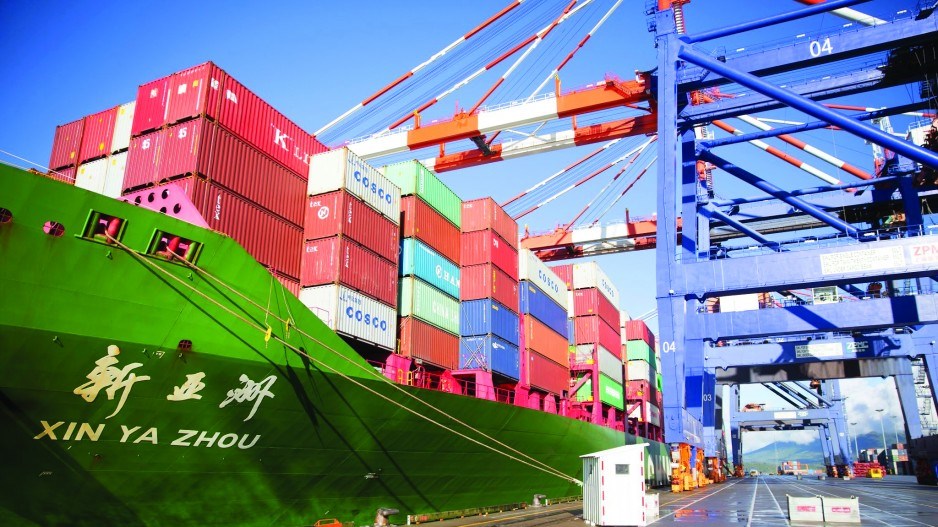Growth in cargo containers handled by the company that operates terminals in the ports of Vancouver and Prince Rupert reflects an optimistic outlook among shipping industry analysts.
But red flags have also been raised over the sector’s underlying health.
The 70.1 million 20-foot equivalent units (TEUs) moved through DP World’s 78 terminals around the world in 2017 represented a 10.1% increase over its 2016 total.
The Dubai-based company operates Vancouver’s Centerm and Prince Rupert’s Fairview container terminals. As of November 2017, container traffic through the Port of Vancouver had increased 10.8% to 2.98 million TEUs compared with the same period in 2016; year-to-date container traffic through the Port of Prince Rupert as of December 2017, meanwhile, was up 26% to 926,540 TEUs.
Last August, DP World unveiled a $200 million expansion to raise the Fairview container terminal’s annual capacity to 1.35 million TEUs from 776,412. The project, which allows the terminal to handle the largest container cargo vessels being deployed in major freighter fleets, is part of DP World’s terminal investment strategy.
In the first six months of 2017, it invested US$595 million in assorted growth markets; its 2017 capital investment guidance was pegged at US$1.2 billion.
DP World has ambitions to increase its cargo handling capacity on Canada’s West Coast to four million TEUs by 2022. Sixty per cent of that total would flow through Prince Rupert as part of a third Fairview expansion that would raise its capacity to between two million and 2.5 million TEUs.
Its investment in Fairview’s expansion comes from the $5 billion funding pool it created in December 2016 in its partnership with Caisse de dépôt et placement du Québec, Canada’s second-largest pension fund manager. DP World originally acquired Fairview from Deutsche Bank (NYSE:DB) in April 2015 for $580 million.
It also plans to invest $350 million in expanding its Centerm container terminal in Burrard Inlet to increase its annual capacity to 1.5 million TEUs from the current 900,000.
Container volume increased in all regions serviced by DP World, especially Australia and the Americas, where gross TEU volume was up 13.8% in 2017 compared with 2016.
DP World’s CEO, Sultan Ahmed Bin Sulayem, pointed to improvements in global trade and market share gains as key factors in the company’s increased cargo numbers, which he noted were ahead of 2017’s global container cargo market growth of around 6%.
During its January 30 container market trends update, U.K.-based shipping consultancy Drewry forecast global container growth to continue at around 4% for 2018, which would add another nine million TEUs to the world’s total this year.
Philip Damas, head of Drewry’s Supply Chain Advisors, said 2018 will be the second year in a row in which every region of the world will see growth.
“For this reason, Drewry has rising confidence in container demand, and we have upgraded our 2018 world TEU forecast from 3.6% to 4.3%,” Damas said.
Volume and rate recovery has also moved major shipping line owners back into the black.
Martin Dixon, Drewry’s Director of Research Products, noted that container carriers collectively lost approximately US$5 billion in 2016 but rebounded with US$7 billion in profit in 2017.
“For 2018, we think profitability will continue and may rise a little bit, similar to 2017,” Dixon said. “Moderating that will be the lower rise we expect in freight rates and the issue of rising fuel costs.”
However, other analysts are more pessimistic about shipping prospects for 2018.
McKinsey & Co.’s Container Shipping: More Mergers, Better Mergers report released in February predicted that the global container sector will continue to struggle with overcapacity, which currently exceeds demand by approximately 20%.
The report from the global management consulting firm added that while container shipping has driven the global economy for the past 25 years, it has failed to deliver value to shareholders.
McKinsey estimated that the sector, without which worldwide GDP would be reduced by US$15 trillion, has “destroyed over US$100 billion in shareholder value over the past 20 years.”
Its report predicted that the large gap between container capacity and demand will persist into the early 2020s.
Danish Ship Finance (DSF) also sees darker clouds on the horizon for shipping lines.
The Copenhagen-based ship financing institute warns that surplus capacity remains a significant issue.
Its November 2017 Shipping Market Review also noted that zero-labour factories continue to take a bigger share of manufacturing production. Many of the automated operations are now in India and China. But, as the DSF report noted, “they could easily be relocated closer to consumers.”
That would reduce the need for long-haul shipping.
Advances in artificial intelligence, 3D printing and robotics, the report predicted, point “to a future in which regionalized manufacturing seems likely.”
It added that smaller container ships (those below 8,000-TEU capacity) could benefit from shrinking fleets as some shipping line owners deploy leaner vessels to service trade routes. That would displace their larger counterparts in a reversal of the recent trend of larger container ships replacing smaller vessels to maximize carrier efficiency on the busiest trade routes.
DSF’s report conceded that it’s too early to call the shift to smaller ships a trend, but it added that the “route to market recovery for the larger vessels seems long and costly.”
It also emphasized the need for shipping companies to embrace digitization’s efficiency and industry cost savings.
“The established players are centrally positioned to benefit from this but could become marginalized if they fail to move into the digital space,” the report stated.
“The champions of disruption are the ones that are creating a new and significantly enhanced value proposition for customers. Such a new value chain holds the potential to redefine the ecosystem of container trading.”
@timothyrenshaw




